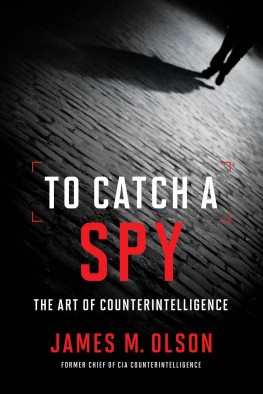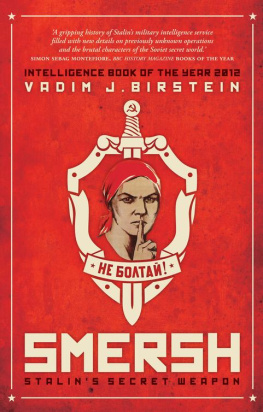To Catch a SpyRelated Titles from Georgetown University Press
American Spies: Espionage against the United States from the Cold War to the Present
Michael J. Sulick
Principled Spying: The Ethics of Secret Intelligence
David Omand and Mark Phythian
Spies, Patriots, and Traitors: American Intelligence in the Revolutionary War
Kenneth A. Daigler
Spying in America: Espionage from the Revolutionary War to the Dawn of the Cold War
Michael J. Sulick
Spy Chiefs: Volume 1: Intelligence Leaders in the United States and United Kingdom
Christopher Moran, Mark Stout, Ioanna Iordanou, and Paul Maddrell, editors
Spy Chiefs: Volume 2: Intelligence Leaders in Europe, the Middle East, and Asia
Paul Maddrell, Christopher Moran, Ioanna Iordanou, and Mark Stout, editors
Spy Sites of Washington, DC: A Guide to the Capital Regions Secret History
Robert Wallace and H. Keith Melton with Henry R. Schlesinger
TO CATCH A SPY
THE ART OF COUNTERINTELLIGENCE
JAMES M. OLSON
Former Chief
of CIA Counterintelligence
2019 James M. Olson. All rights reserved. No part of this book may be reproduced or utilized in any form or by any means, electronic or mechanical, including photocopying and recording, or by any information storage and retrieval system, without permission in writing from the publisher.
The publisher is not responsible for third-party websites or their content. URL links were active at time of publication.
Publication of this book does not constitute an official release of CIA information. All statements of fact, opinion, or analysis expressed are those of the author and do not reflect the official positions or views of the Central Intelligence Agency (CIA) or any other US government agency. Nothing in the contents should be construed as asserting or implying US government authentication of information or CIA endorsement of the authors views. This material has been reviewed solely for classification.
Library of Congress Cataloging-in-Publication Data
Names: Olson, James M., 1941- author.
Title: To catch a spy : the art of counterintelligence / James M. Olson.
Description: Washington, DC : Georgetown University Press, 2019. | Includes bibliographical references and index.
Identifiers: LCCN 2018043578 (print) | LCCN 2018046471 (ebook) | ISBN 9781626166806 (hardcover : alk. paper) | ISBN 9781626166813 (ebook)
Subjects: LCSH: Intelligence serviceUnited States. | EspionageUnited States. | SpiesUnited States. | Intelligence serviceChina. | Espionage, ChineseUnited States. | Intelligence serviceRussia (Federation) | Espionage, RussianUnited States. | Intelligence serviceCuba. | Espionage, CubanUnited States.
Classification: LCC UB271.U5 (ebook) | LCC UB271.U5 O47 2019 (print) | DDC 327.1273dc23
LC record available at https://lccn.loc.gov/2018043578

This book is printed on acid-free paper meeting the requirements of the American National Standard for Permanence in Paper for Printed Library Materials.
20 19 9 8 7 6 5 4 3 2 First printing
Printed in the United States of America.
Jacket design by Faceout Studio, Tim Green. Cover image by tunart / iStock by Getty Images.
To my students at the Bush School of Government and Public Service
of Texas A&M University who inspire me every day
with their dedication and commitment to serving our country.
CONTENTS
ACKNOWLEDGMENTS
My sincerest thanks go first to the Central Intelligence Agency (CIA) for assigning me to the brand new Bush School of Government and Public Service at Texas A&M University in 1998 to assist in developing a graduate program in intelligence studies. I was part of the CIAs Officer in Residence program, which had for its purpose to send experienced CIA officers to various universities at their request to promote the teaching of intelligence as an academic discipline. My assignment was for two years, after which I was expected to return to Washington for a new job in clandestine operations. It did not work out that way. My wife, Meredith, and I quickly grew to love the Bush School, Texas A&M, the students, the faculty, the community, and our many new friends. When the time came for us to return to Washington, we were deeply conflicted. I was being offered a nice job in the Directorate of Operations at headquarters, but I had by then discovered that I had a passion for teaching. Meredith, who had also worked at the CIA, was in nursing school and was looking forward to launching her second career here. I felt guilty about not going back, but Meredith finally convinced me that I could do more good for our country by staying here and preparing the next generation of national security public servants than I could by sitting at a desk in Washington.
I owe a deep debt of gratitude also to the faculty and staff of the Bush School, who accepted this non-PhD practitioner spy guy into their school and patiently taught him the ropes of academia. I would be remiss in not singling out for special thanks the first dean of the Bush School, Dr. Charles Hermann, who took me under his wing and gave me his full support. He is still on the faculty of the Bush School. Chuck and his wife, Lorraine, are Merediths and my closest friends here, and we will be forever grateful to them for their many kindnesses to us.
The manuscript for this book was reviewed and approved by the Publications Review Board (PRB) of the CIA before anyone else, including the publisher, could see it. I am favorably impressed by the fairness and professionalism of the CIAs review process. The PRB ensures that nothing I write reveals classified information or puts past, present, or future operations in jeopardy. All CIA officers sign a legally binding lifetime secrecy agreement when they enter on duty. This book is a summation of my many years in counterintelligence, specifically my recommendations on how US counterintelligence can be improved and how the costly mistakes of the past can be avoided. I do not speak for the CIA or any other government agency; my views are strictly personal and should be regarded as such.
My agent, Sam Dorrance, guided me through each stage of the editing, negotiating, and publishing process, thereby freeing me to concentrate on my writing. Sam is a real pro, and I feel very fortunate to have had the chance to work with him. Thank you, Sam.
I would also like to acknowledge the invaluable contributions of my students Andrew Domel, Jessica Koloini, Cassidy Dobbins, Sean Danielson, and Adreanna Scribner, who did intensive counterintelligence study under my direction and allowed me to use their research in the writing of this book. They saved me countless hours and unearthed details I would have missed without their help. I hope my students know how proud I am of them. Fine things are in store for all of them.
Finally, I could not have done what I did in my spying and teaching careers without the constant love and support of my wife, Meredith; my sons, Jeremy and Joshua; and my daughter, Hillary. I love them more than words can express. And on top of everything else, our three children have given Meredith and me eleven grandchildren: Simeon, Ruby, Stuart, Amelia, Bridget, Benjamin, Patrick, Gideon, Chiri, Jasper, and Josephine. They are the joy of our life.














 This book is printed on acid-free paper meeting the requirements of the American National Standard for Permanence in Paper for Printed Library Materials.
This book is printed on acid-free paper meeting the requirements of the American National Standard for Permanence in Paper for Printed Library Materials.